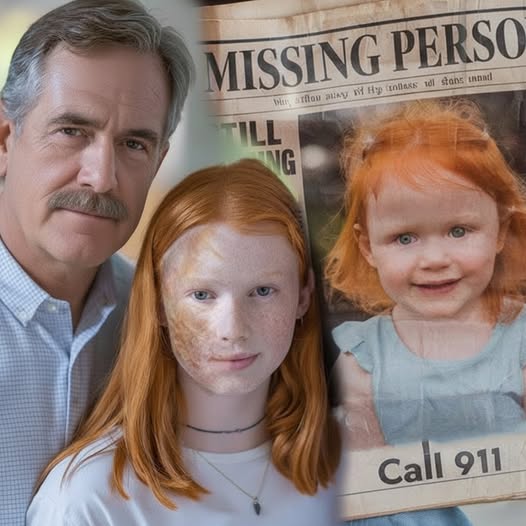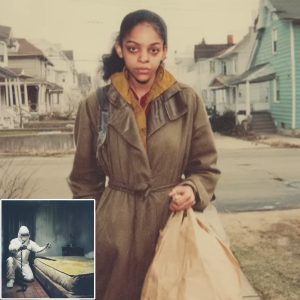The girl had always trusted her parents’ story that the scar on her face came from a house fire when she was a child — until, at twelve, she uncovered the truth they had kept from her….When Lily Hart was little, she used to trace the pale scar running from her left temple down to her jaw with a kind of quiet fascination. Her parents always told her the same story — that when she was three, their old house in Vermont caught fire. Her mother, sobbing, would say she had pulled Lily out just in time, but a falling beam had left the mark that would stay forever. Her father would add, “You were our miracle, sweetheart. That scar is proof you survived.”
It was a story Lily grew up believing like gospel. She’d tell it at school when kids asked, embarrassed but proud, as if the scar gave her a tragic kind of strength.
By twelve, Lily had long learned to live with it. Her parents had moved from Vermont to a quiet suburb in Oregon, and the scar had faded into something less noticeable. But that summer, curiosity—mixed with the stubbornness of adolescence—made her dig into the past. It started innocently: a school genealogy project. She wanted photos of the “house fire” for her presentation.
Her mother froze when she asked. “Oh, honey, we lost everything in that fire,” she said too quickly. Her father nodded, avoiding her eyes. The conversation ended there, but the seed of doubt was planted.
A week later, while her parents were at work, Lily snuck into the attic looking for old boxes. Most were labeled with her parents’ names, full of tax papers and faded clothes. But one box, shoved behind a stack of Christmas decorations, was labeled “L—2008.”
Inside were hospital forms, a police report, and several photographs. Her tiny heart thudded as she read the words on the first page:
“Patient: Lily Hart. Admitted for facial laceration. Case referred to Child Protective Services—suspected abuse.”
The breath left her lungs. Abuse? She flipped through the papers, her eyes catching on a name: Rachel Kline.
The next photograph made her knees buckle. A younger version of her mother, hair tied back, eyes hollow, sitting in a police station. The caption underneath read, “Mother denies incident; claims injury was accidental.”
The fire story—every bedtime retelling, every comforting lie—crumbled in an instant. Her scar wasn’t from a fire. It was from something much darker, something her parents had buried deep enough for even her to forget.
And now, Lily knew she had to find out the truth….

Lily sat perfectly still on the attic floor, the box open beside her like a wound. Her hands trembled as she lifted another document.
“Incident Report — March 14, 2008.”
“Injury sustained during domestic altercation.”
Domestic… what?
Her throat tightened. Her parents had never yelled, never slammed doors, never raised a hand in all the years she could remember. They were gentle, patient, the kind of people teachers praised and neighbors trusted. The idea of them being capable of hurting her felt impossible—like gravity working backward.
She forced herself to keep reading.
At the bottom of the report was scrawled handwriting in blue ink:
“Injury consistent with object impact, not accidental fall as stated.”
Lily’s pulse thudded deep in her ears.
Object impact.
Not a fire.
Not a beam.
Not an accident.
Her chest constricted so tightly she could barely breathe.
But the most terrifying part was the name that appeared over and over:
Rachel Kline — her mother’s maiden name.
As if at some point, Rachel Hart had needed to be someone else.
Lily reached for the photographs next. The first showed her at three years old, a tiny girl with wide eyes and a bandage covering half her face. The second was a photo of her mother—Rachel—sitting in a police interview room, jaw clenched, eyes red but dry.
The third photo made Lily go cold.
It was of a kitchen.
Bright. Ordinary. Except for a metal saucepan lying on the floor and a dark, spreading stain beside it.
Her stomach lurched. She dropped the photo as though it burned her fingers.
She wasn’t supposed to see this.
Someone had hidden it for a reason.
A sudden creak from downstairs jolted her back to herself.
The garage door.
Her parents were home.
Heart pounding, Lily shoved everything back into the box, closed the lid, and hid it where she’d found it. Her mind raced. Questions screamed inside her head, louder than her heartbeat.
Did her mother really hurt her?
Why did they lie about a fire?
Why did Child Protective Services get involved?
Why did they change states?
And most terrifying of all:
What else had they lied about?
She climbed down the attic ladder on shaky legs and hurried to her room. She barely had time to sit on her bed before her mother appeared in the doorway, smiling in that familiar way that used to make her feel safe.
“There’s my girl,” her mother said. “How was your day?”
Lily studied her face—the softness, the warmth, the gentleness.
The same woman from the police photo.
A woman she suddenly realized she didn’t fully know.
Her voice came out thin, almost a whisper.
“Mom… what happened when I was three?”
Her mother froze. The color drained from her face. Her hand tightened on the doorframe.
“Lily,” she whispered, “why are you asking that?”
Lily tried to hold her gaze, but fear curled in her stomach like a fist.
“Because,” she said, “I found the box.”
Her mother swayed as if someone had struck her.
For a long, silent moment, her mother didn’t speak. Then she stepped into the room, closed the door behind her, and sat beside Lily with trembling hands.
“Honey…” she whispered, voice cracking. “There are things I never wanted you to remember.”
Lily stared back, her heart pounding.
“Tell me the truth.”
Her mother took a long, broken breath.
“Okay,” she said. “But you need to understand… I wasn’t the one you needed saving from.”
Lily’s skin prickled.
The truth was worse than she imagined—
and it was only beginning.





